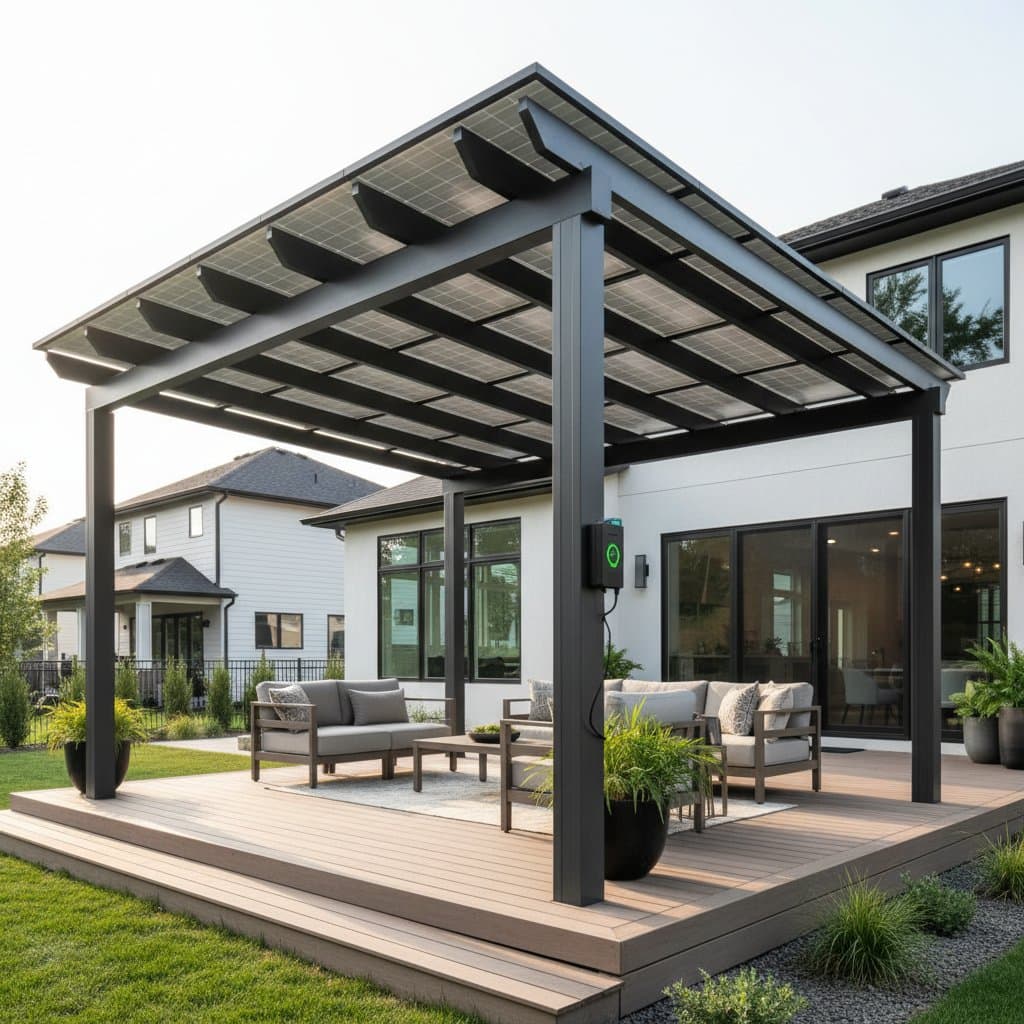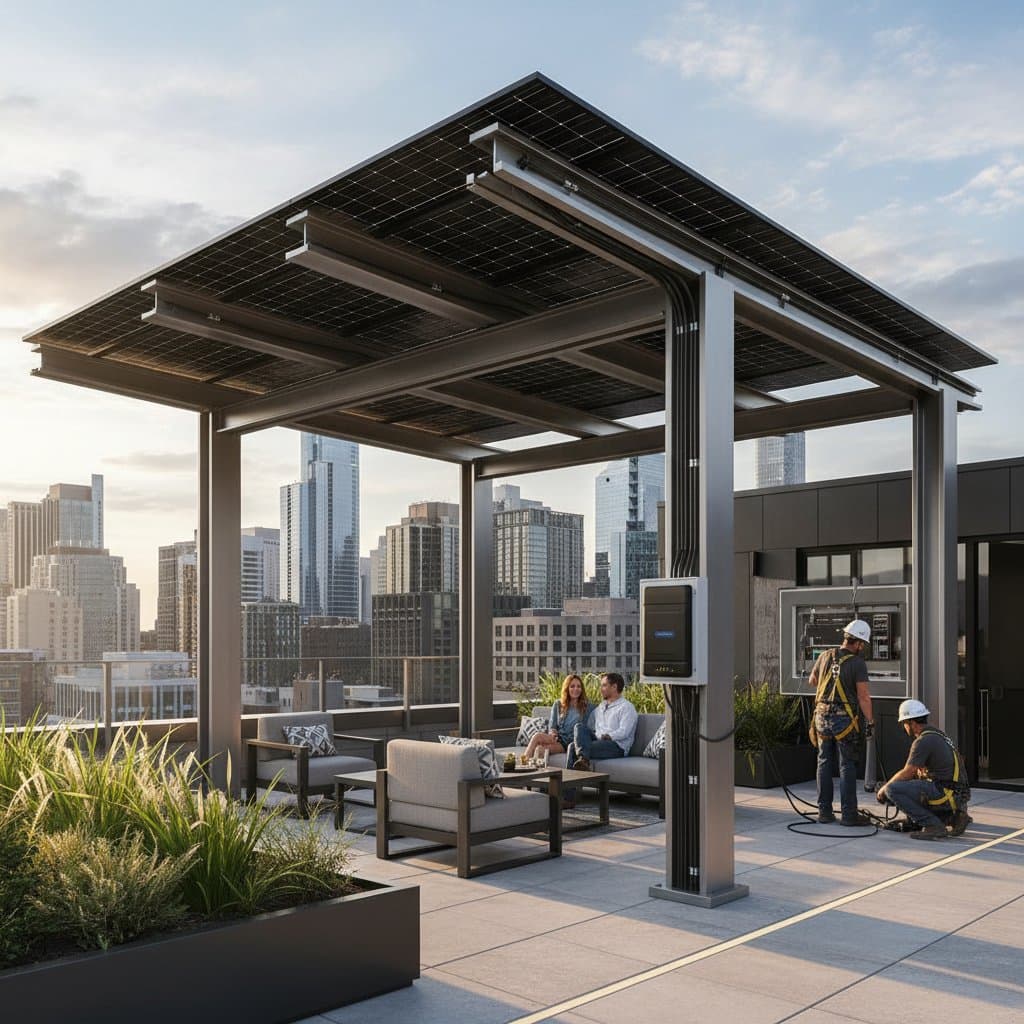Introduction
Solar pergolas represent a smart fusion of outdoor architecture and renewable energy technology. These structures provide essential shade for decks while harnessing sunlight to generate electricity. Homeowners increasingly adopt them to enhance living spaces in sustainable ways.
In 2025, solar pergolas emerge as a leading trend for urban and suburban properties. They address common challenges like excessive heat and rising energy bills. This guide outlines key aspects to help you integrate one into your home.
Understanding Solar Pergolas
A solar pergola consists of a lattice-style framework topped with photovoltaic panels. Unlike traditional pergolas, which offer only partial shade through wooden or metal slats, solar versions incorporate integrated solar cells. These panels capture sunlight and convert it into usable power for your home.
The design maintains an open, airy feel that complements natural surroundings. Panels are typically mounted on sturdy aluminum or steel frames, ensuring durability against weather elements. Sizes vary from compact 10-foot by 10-foot units to expansive covers spanning entire decks.
Installation connects the system to your home's electrical grid or a battery storage unit. This setup allows excess energy production to offset utility costs or power outdoor features like lights and fans.
Key Benefits of Installing a Solar Pergola
Solar pergolas deliver multiple advantages that extend beyond basic shading. They contribute to energy independence and environmental health while improving property appeal.
Renewable Energy Production
Each pergola functions as a mini power plant. Depending on location and panel efficiency, a standard unit generates 2 to 5 kilowatts of electricity annually. This output powers household appliances or charges electric vehicles, reducing reliance on fossil fuels.
In sunny regions, production peaks during summer months when shade is most needed. Advanced inverters ensure safe integration with existing systems, preventing overloads. Over time, this generation translates to significant savings on electricity statements.
Enhanced Comfort and Shade
The primary role of any pergola is to create a shaded retreat. Solar models achieve this without blocking all light, allowing dappled sunlight to filter through. This balance prevents the greenhouse effect common under solid roofs.
Temperatures under the structure drop by up to 20 degrees Fahrenheit compared to exposed areas. Integrate retractable fabrics or louvers for adjustable coverage. Such features make decks usable from dawn until dusk, even on hot days.
Environmental and Financial Gains
By producing clean energy, solar pergolas lower your carbon footprint. They support global efforts to combat climate change through localized actions. Additionally, many regions offer incentives like tax credits that offset initial expenses.
Home values increase with eco-friendly upgrades. Studies indicate that sustainable features boost resale prices by 5 to 10 percent. The structure also protects underlying deck materials from UV damage, extending their lifespan.
Design and Customization Options
Selecting the right solar pergola involves considering your deck's layout and personal style. Start by assessing available space and sunlight exposure. South-facing orientations maximize energy yield in the Northern Hemisphere.
Choose materials that withstand local climate conditions. Powder-coated aluminum resists corrosion, while cedar accents add warmth. Panel types include monocrystalline for high efficiency or polycrystalline for cost-effectiveness.
Customization extends to aesthetics and functionality:
- Modular Panels: Easy to expand as needs grow.
- Smart Integration: Add sensors for automatic adjustments based on weather.
- Lighting and Outlets: Built-in LED strips and USB ports for evening use.
- Planting Integration: Lattice sides support climbing vines for natural privacy.
Consult local regulations early. Permits may require structural engineering reviews, especially for rooftop-adjacent installations.
Cost Breakdown and Return on Investment
Initial costs for a solar pergola range from $5,000 to $15,000, depending on size and features. Basic models start at the lower end, while premium setups with batteries exceed $20,000. Factor in professional installation fees, which add $1,000 to $3,000.
Energy savings recoup expenses over 5 to 10 years. A 3-kilowatt system might save $500 annually in electricity costs. Combine this with rebates from programs like the federal Investment Tax Credit, which covers 30 percent of qualified expenses.
Long-term ROI includes reduced maintenance compared to traditional roofs. Panels come with 25-year warranties, ensuring reliable performance. Track savings with monitoring apps provided by manufacturers.
Step-by-Step Installation Guide
Professional installation ensures safety and efficiency. The process unfolds in phases:
- Site Assessment: Evaluate deck stability and solar potential using tools like shade calculators.
- Design Approval: Finalize blueprints with an architect or supplier.
- Foundation Preparation: Secure posts into concrete footings or existing deck framing.
- Framework Assembly: Erect beams and rafters, then mount panels securely.
- Electrical Wiring: Connect to inverters and the home grid, following code standards.
- Testing and Activation: Verify output and safety before full operation.
Timeline varies from one week for simple setups to a month for complex projects. Hire certified installers to qualify for warranties and incentives.
Maintenance Essentials
Solar pergolas require minimal upkeep to sustain performance. Inspect panels quarterly for debris like leaves or bird droppings, which reduce efficiency. Gentle cleaning with water and a soft brush restores output without damaging coatings.
Check frame connections annually for loose bolts, tightening as needed. In harsh winters, remove snow accumulation to prevent stress on supports. Monitor system performance through integrated software to detect issues early.
Professional servicing every two years ensures longevity. Address minor repairs promptly to avoid voiding warranties. With proper care, these structures last 20 to 30 years.
Realizing Long-Term Value
Investing in a solar pergola transforms your deck into a productive, enjoyable extension of your home. It delivers immediate shade and comfort alongside ongoing energy benefits. As technology advances, future upgrades will further enhance returns.
Plan your project with these insights to achieve a seamless blend of form and function. Your outdoor space will not only shelter gatherings but also power a greener lifestyle.





